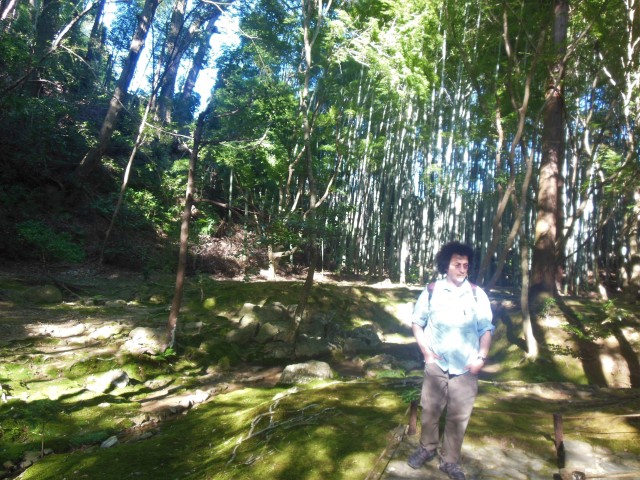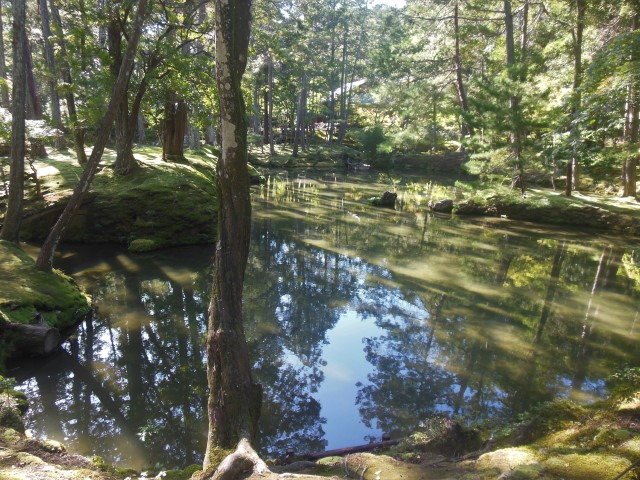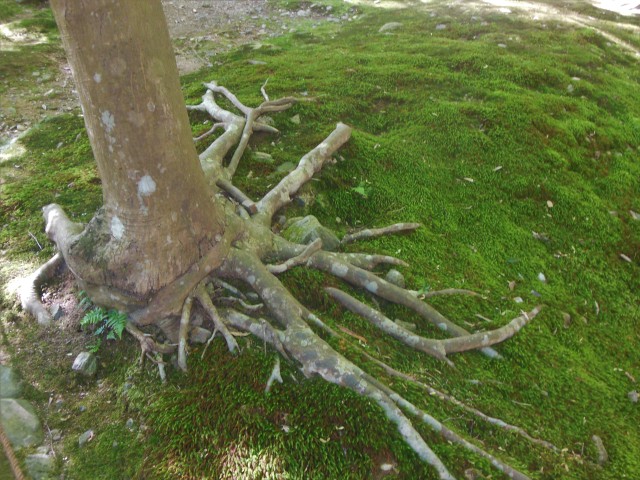In 48 hours: one flight from Chicago to Tokyo, one bullet train from Tokyo to Kyoto, nine subway rides, one bus and one frantic taxi ride after a different bus didn’t show up as scheduled. We arrived at the Moss Temple just in time for the admission slot which our hotel managed to reserve for us (after several google-translate enabled email exchanges.) Hungry—no time for lunch—with our heads swimming from the 14 hour time zone leap, we followed a monk to copy out a sutra at a low table. On completing the sutra, we wrote a wish next to the inked-in text and dropped it at the temple’s altar. Now we were set free to explore the temple grounds.

When planning our trip to Japan, I read some reviews of Moss Temple, which described it along the lines of “Experience the beauty of nature.”
Moss Temple is beautiful.
Moss temple is not nature.
The best way to think about Saihoji—which is the official name of Moss Temple—is as a work of art created from natural elements.

Supposedly there are 120 types of moss in Saihoji, which is kind of hilarious. Like isn’t Zen supposed to be all austere? But these Zen monks are practically rolling around in velvety excess.
Hilarity aside, think of it: moss as art medium. No photo can capture the lushness, depth and luminescence.

There’s the moss…and the light. These Zen monks have even art directed the perfect light. 120 types of moss, dappled with light. Light slanted sideways, so the trees throw out linear shadows. Honey colored—not brass—light. Light washed over like a watercolor, tree branches picked out here and there and highlighted ice blue.


Water is standard garden fare, of course, but our monks have that too, just like some 4 star chefs make Nouvelle cuisine versions of childhood comfort foods.

Once I stopped gaping at the moss and the light, I looked closer at the trees, which are sculptural. Notice the trunk of the tree in the foreground of this photo is delicately twisted.

Consider the tree’s roots, arranged just so.

Look across the pond, where all the trees are growing at the same angle.

No, really, what is the deal with the trees? Each tree seems to come straight out of an illustration from The Tale of Genji.

HOB and I walked through the garden once, a second time, and then a third time in reverse. Just as a monk came to tell us we had to leave because he was locking the gate, I saw this contraption tied to a tree’s branches.
As we had only just arrived in Japan the night before, I didn’t yet realize this type of tree manipulation is a common sight in Japan. The landscape artists of Saihoji are just much more discreet about the way they work, have wrestled with and transformed nature here since it began as a Zen temple in 1339.

Throughout our trip to Japan we saw trees stretched, clamped, propped, split open, wearing girdles, and stripped of leaves on the bottom so that they grew up with bouncy heads.

For a country with Shinto as the dominant, ostensibly nature-based religion, the Japanese people don’t seem to feel much of a need to keep nature natural.
I kind of agree with them.
One advantage of my terrible pre-college education was that, when I started at the University with the usual freshman survey courses, all the ideas were new to me, rather than mainly reviews of subjects studied in high school, as they were with other students. The concepts I studied would hit me fresh—every day a new “Gah! Ah! Yes!”
One such mini-brain explosion came in a Poli Sci survey. We were reading about the social contract and when I got to Thomas Hobbes’ Leviathan and his description of life in a state of nature as “solitary, poor, nasty, brutish, and short” I was filled with certainty of it.

When you enter a subway train in Japan, the people line up neatly, and enter calmly without shoving, even in rush hour. No one talks on their cell phone anywhere in public. They don’t honk their horns. They don’t even walk while eating or drinking, to avoid possibly running into someone and creating a mess. There are hardly any trash cans, but no litter. Public bathrooms are clean, parks are clean—-everything is clean, and of course safe. We saw unsecured bikes. We were not subjected to scam attempts. Japanese people are so almost comically helpful and friendly that we would often be escorted to our destination by people helping us find our way. The police appear to be around mostly to assist people, not to prevent crime.
I don’t know enough about the history of Japan to understand how it got to be this way, so orderly, so safe, so clean, but it seems like all of Japanese people have internalized the social contract. Are they suffering because of it? Nope, not so you would notice. Perhaps Japanese social forces are like the landscape artists of the Moss Temple—they applied the braces, girdles and clamps for so long and so discreetly that there’s no pain in manipulation, no longing to cut of the girdle, to go back to brutal nature.
It’s too late for me to live this way, but God, I envy them.

How we got to Kyoto: train from Tokyo.
Where we slept: Japaning Hotel Liv Ranrokaku Price: €100 for a double. Recommended: yes.


Very interesting. I’d hadn’t heard of the moss temple until now. Thank you for sharing that. Now I want to go to Japan – no one talks on their cell phones in public??? is that even possible?
LikeLike
Thanks—I learned about it from my co-worker. Getting a reservation is complicated but it keeps the place from being overcrowded.
Seriously, I didn’t see anyone talking on a cell phone, and I didn’t hear any Japanese people raise their voices either!
LikeLike
I’m afraid that as a Gaijin I found subway signs hilarious: there was one which taught you how to sit or stand so as to cause minimal obstruction to others. Is the sign even needed for the locals? A customs officer once checked my bags and left it better arranged than I had done myself. I’ve been walked to my destination so often that I’m afraid to ask for directions nowadays. But there are safety valves too, and you might see some of them letting off the pressure.
LikeLiked by 1 person
Do you have a photos of those signs?
Please give me an example of the safety valves.
LikeLike
No photos unfortunately. Look for them near the doors of metro coaches in the Tokyo area.
Bing extremely drunk in public seems to be quite permissible, for one thing.
LikeLiked by 1 person
Oh yes, I think I did see this.
I would add public napping, which may be related to the public drunkenness.
LikeLike
Public napping? That’s normal across Asia, southern Europe, and Africa. Perfectly human,
LikeLiked by 1 person
I agree that there’s something very nice about Japan in the respect that they show for each other. Then, though, they can build monstruosities such as enormous electricity pylons, three times higher than the trees, or rice paddies with concrete, ehm, “borders”. It’s an enigmatic place, but such a nice one.
LikeLiked by 1 person
I envy the quality of life and the infrastructure (maybe not the pylons). I wouldn’t fit in in the least, though—direct speaking slob that I am. It would be really hard not to fill guilty about all that packaging too. These nice people, they are generating piles and piles of single use plastics.
LikeLiked by 1 person
Someone else who only likes curated nature! I assume there are no snakes in this place, which is a huge point for me. And super-considerate people too! I will say that folks in my adopted hometown of Steamboat Springs are somewhat comparable, at least most of the time. Happy civilized travels!
LikeLiked by 1 person
You have the hot springs in Steamboat Springs too, just like Japan.
We saw no snakes, though Japan still hasn’t learned to curate mosquitoes,or typhoons for that matter. An encounter with the latter is why we had to scrap our plans to spend time in actual, non curated nature.
LikeLike
I’m not sure that I want to think of generations of ancestors girdled and guided into automatic politeness…though the kindness is a bonus, as it is in Costa Rica where no girdling whatsoever has taken place as far as I can see!
I am enjoying your insights into life in Japan, having been brought up in a household where ‘Japanese’ was a dirty word following the Second World War, as father lost so many friends taken into the bag in Singapore.
LikeLiked by 1 person
Perhaps we’ve been lucky, but we find kind people wherever we travel. This degree of conformity to social norms, however, is a new one to me, and rather uncomfortable if enviable.
Must go to Costa Rica!
Hard to believe that Japan was the enemy in the 1st half of the 20th century and that the Japanese didn’t seem to hate us for dropping nuclear bombs on them.
LikeLiked by 1 person
We too have found kind people everywhere we have been…I think most people are decent,,,but the media don’t often feature kindness and decency!
I cannot imagine how people could forgive the use of the A bomb….
LikeLiked by 1 person
Your post was fascinating and incredibly poetic. Very thought provoking. And beautiful pictures! But I can’t imagine living in a society that is so very disciplined. I am pretty sure I’d be a huge failure – I’m way too westernized. Now something in between – I think I could do that!
LikeLiked by 1 person
Thanks! I understand it could be really patronizing to go to someplace for a couple of weeks and be all like “Well you people are this and that” but I do want to have my own experiences and that’s really what I experienced. Japan is a democracy and they are living so well (maybe some work to do in the area of women’s equality but that’s another post.) I’ll take the safety and the social cohesion but like you, I wouldn’t do so well with the discipline. Me and my sassy mouth!
LikeLike
The moss garden we saw in Kyoto was amazing. It requires a whole different aesthetic to keep it neat like that.
LikeLiked by 1 person
How did you manage to get a reservation from Canada?
LikeLike
I believe we went to a different temple and garden. It’s in the blog post since I can’t remember the name off the top of my head.
LikeLiked by 1 person
Yes, you went to a different one—also gorgeous—I enjoyed your photos of the neighborhood.
LikeLike
LikeLiked by 1 person